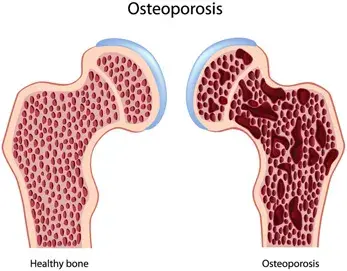Osteoporosis is the most common bone disease that involves abnormal loss of bony tissue resulting in fragile or porous bones. According to the National Osteoporosis Foundation (NOF), two million broken bones occur every year due to osteoporosis in the United States. The NOF also reports that around 9 million Americans have osteoporosis while 43 million have low bone density with increased risk of osteoporosis. With the increased number of people with coverage in 2015 following the Affordable Care Act (ACA), providers can definitely see more people with osteoporosis or low bone density in their offices. Therefore, accurate osteoporosis medical coding is very important in 2015.
BMM Screening
Providers conduct bone mass measurement (BMM) screening for patients visiting their offices with bone problems to identify bone mass, detect bone loss, or determine bone quality once every two years (more often, if medically necessary). This is the procedure used to confirm osteoporosis in patients and helps physicians to provide the necessary treatment. Billing for BMM screening is therefore quite important. Medicare provides coverage for this preventive service. The copayment/coinsurance and deductible are waived for BMM screening since it is a preventive service.
Different technologies are used for this screening and the procedure codes will depend on the technology used. Since single and dual photon absorptiometry are no longer used, CPT codes 78350 and 78351 have been deleted for 2015 reporting. The bone mass procedure codes payable under Medicare in 2015 are:
CPT codes
- 76977: Ultrasound bone density measurement and interpretation, peripheral site(s), any method
- 77078: Computed tomography, bone mineral density study, 1 or more sites; axial skeleton (eg, hips, pelvis, spine)
- 77080: Dual-energy X-ray absorptiometry (DXA), bone density study, 1 or more sites; axial skeleton (eg, hips, pelvis, spine)
- 77081: Dual-energy X-ray absorptiometry (DXA), bone density study, 1 or more sites; appendicular skeleton (peripheral) (eg, radius, wrist, heel)
- 77085: Dual-energy X-ray absorptiometry (DXA), bone density study, 1 or more sites; axial skeleton (eg, hips, pelvis, spine), including vertebral fracture assessment
- 77086: Vertebral fracture assessment via dual-energy X-ray absorptiometry (DXA)
HCPCS code
- G0130: Single energy X-ray absorptiometry (Sexa) bone density study, one or more sites; appendicular skeleton (peripheral) (eg, radius, wrist, heel)
Diagnosis and Medical Necessity
In order to cover a BMM study, a patient must meet at least one of the five conditions given below.
- Estrogen-deficient
- Vertebral abnormality
- Steroid treatment
- Hyperparathyroidism
- Osteoporosis drug therapy monitoring
ICD-9-CM diagnosis coding depends upon the bone mass procedure being reported. For example, ICD-9 codes that support 77080 include:
- 733.0: Osteoporosis
- 733.01: Senile osteoporosis
- 733.02: Idiopathic osteoporosis
- 733.03: Disuse osteoporosis
- 733.09: Other osteoporosis
- 733.90: Disorder of bone and cartilage, unspecified
- V58.65: Long-term (current) use of steroids
- V58.68: Long term (current) use of bisphosphonates
- V58.69: Long-term (current) use of other medications
- 255.0: Cushing’s syndrome
The acceptable diagnosis codes for the remaining bone mass procedures mentioned earlier include: 252.01, 256.2, 256.31, 627.1, 627.2, 627.3, 627.4, 627.8, 733.13, 805.00 – 805.7, 806.00 – 806.79, V49.81, V58.65, and V58.69.
Coding Osteoporosis with ICD-10-CM
As the implementation of the new coding system ICD-10-CM is due on October 1, 2015, it is necessary to understand more specific ICD-10 codes for osteoporosis.
Osteoporosis with Fractures 11.30
You should report a code from M80-series if the patient who visits your office has a current pathological fracture during the time of encounter. The codes should be selected according to the site of the fracture, not the location of the osteoporosis. The laterality (right/left) should also be considered. Here are some sample codes:
- M80.011: Age-related osteoporosis with current pathological fracture, right shoulder
- M80.012: Age-related osteoporosis with current pathological fracture, left shoulder
- M80.019: Age-related osteoporosis with current pathological fracture, unspecified shoulder
M80-series codes also require a seventh character to specify episode of care, such as:
- A, initial encounter for fracture
- D, subsequent encounter for fracture with routine healing
- G, subsequent encounter for fracture with delayed healing
- K, subsequent encounter for fracture with nonunion
- P, subsequent encounter for fracture with malunion
- S, sequela
Osteoporosis without Fractures
If the patient does not have a current pathological fracture, you should select a code from M81-series even if the patient had pathological fracture in the past. There are only three codes in this series such as:
- M81.0: Age-related osteoporosis without current pathological fracture
- M81.6: Localized osteoporosis [Lequesne]
- M81.8: Other osteoporosis without current pathological fracture
Site is not relevant for this category of codes since osteoporosis is a systemic condition. Even so, you should report status code Z87.310 (personal history of [healed] osteoporosis fracture) after the osteoporosis code, if applicable.


